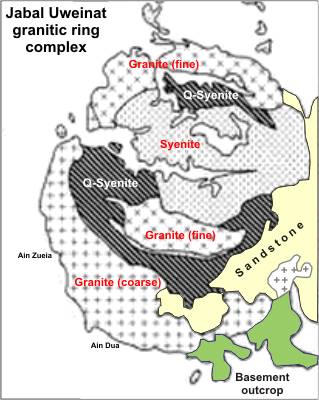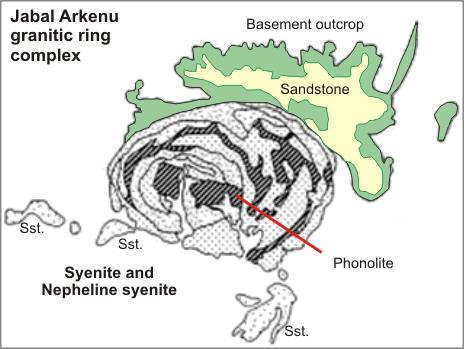|
The oldest intrusive rocks on the Uweinat-Howar Uplift are of Precambrian
age. By their general geologic setting, macroscopic appearance and bulk composition,
at least two principal suites can be recognized (RICHTER 1986):
Settings
of red alkaline granites and grey-green granitoids of Precambrian age can
be observed as batholiths in the Jebel Kamil and Jebel Nazar
in Egypt.
are
of Paleozoic age and are only present in the Jebel Kamil and
Jebel Nazar complexes where they form medium to small-sized, irregularly
shaped intrusions. The age of these granites was determined with 430 - 480
Ma (Ordovician). They have intruded migmatites and orthogneiss.
are
of Tertiary age. The most prominent one is Jabal Uwainat, the
intrusive part of the massive is almost completely situated in Libya. Another
ring complex is Jabal Babein to the north of Jabal Uweinat, nearby
the border between Libya and Egypt. Ring complexes lying completely inside
Libya are Jabal Arkenu and Jabal Bahari. In the southeast,
in Sudan, the ring complex of Jebel Kissu is rising as a prominent
landmark above the gravel plains.
The dessected oval structure of the Jabal Babein, with its longer axis
trending north-northwest, is emplaced in Precambrian gneiss and red granite.
The highly complex intrusion is essentially composed of outer quartz syenite
ring-dyke and a central white, medium to fine-grained, granite. The syenite
shows little variation, and is a pink, coarse-grained, equigranular rock containing
major perthitic alk-feldspar, subordinate plagioklase with minor biotite and
quartz. Basic to acidic cone sheets are intercalated and, in many places,
variably composed dykes have penetrated the complex.
Jabal Bahari appears to consist of a single ring dyke of medium to
coarse-grained pink granite, while Jabal Arkenu is mainly made up of
medium to coarse-grained nepheline syenite beside subordinate syenite with
trachyte and pyroclastic phonolithe in the centre. Jebel Kissu is built
up by a steep outer ring of coarse-grained syenite, deeply weathered to large
boulders, and a centre of sheeted, fine-grained quartz syenite. The complex
is cut by frequent dykes of intermediate to basic composition and variable
thickness.
|

|
|
In the Jabal
Uweinat (Libya) we can see the unusual circular structure. These structure
are the surface expression of a granitic intrusion. This granite intruded
into the Archaen/Proterozoic metamorphic Basement as well as Paleozoic sandstone
strata along a ring fracture. Three igneous activities has occured probably
in the Early Oligocene age (42-46 Ma).
The composite intrusion of the Jabal Uweinat is roughly circular with a diameter
of about 23 km, and is flanked on the northern side by three smaller overlapping
intrusive rings which are aligned along a north-northeast-trending axis. The
main complex is composed of deeply weathered alkaline rocks, forming very
large well-rounded blocks. The outer rim is formed by coarse-grained quartz
syenite which steeply slopes toward the surrounding basement. The rock is
assembled of quartz up to 12% and major euhedral perthitic alk-feldspar beside
minor aegirine. Toward the centre, in the south and west, the outer intrusive
ring is followed by a highly complex zone of coarse-grained quartz syenite
and coarse to fine-grained alkali granite. This zone forms the outer rim in
the north. According to KLERKX & RANDLE (1976), similar to the syenite the
alkali granite is essentially composed of subhedral alk-feldspar but with
an increased amount of interstitial quartz and aegirine. The central depression
of the ring complex is occupied by a reddish, fine-grained quartz syenite
with trachytic matrix that encloses rare phenocrysts of K-feldspar. The rock
is locally cut by trachytic dykes and sills. A steep inner slope around the
central quartz syenite depression is build up by alternating cone-sheets of
syenite, consisting largely of perthite with no quartz.
|


